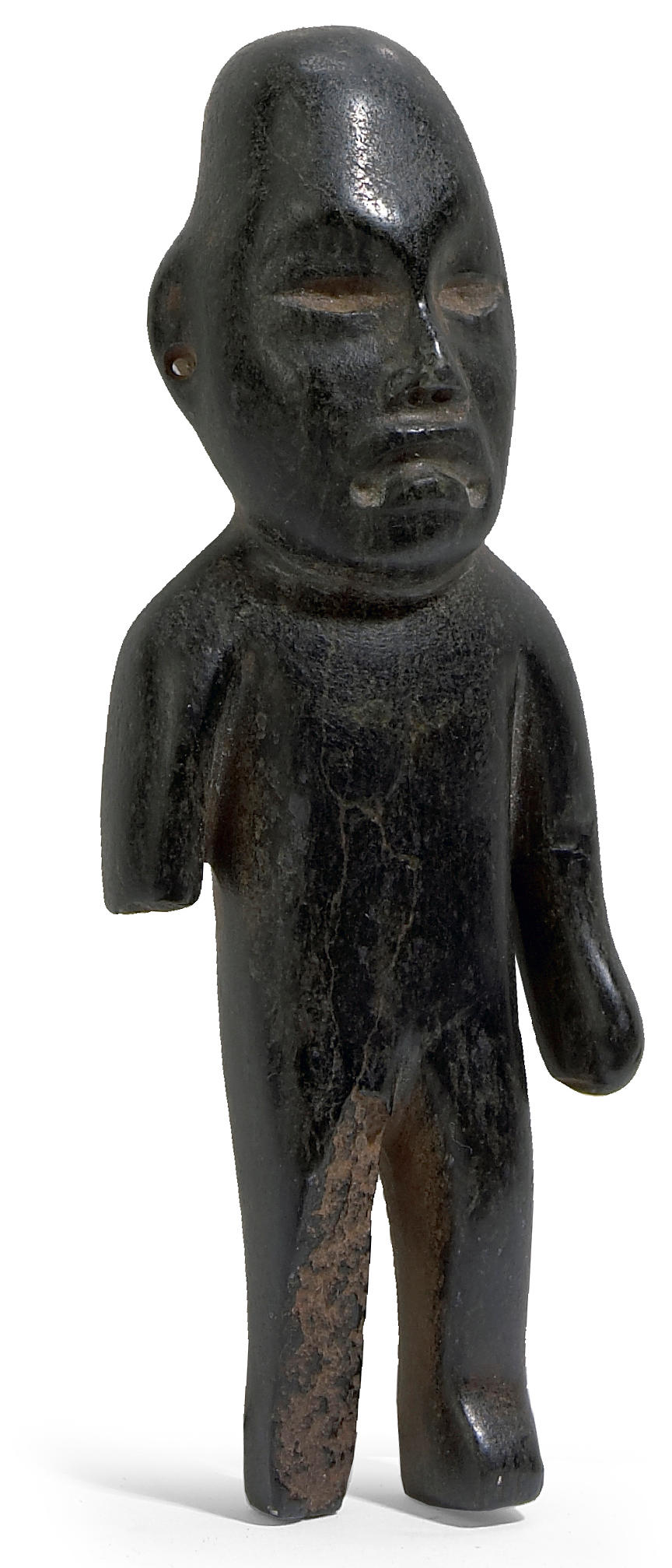diameter 5in, height 2 1/2in Scrap bowls and spittoons (ipu 'aina) were made for chiefs, who deposited fishbones and scraps of food during meals in the former, and spittle, hair and nail parings in the latter. This careful segregation of food and bodily remains was instituted because of the prevailing fear of sorcery, for food and bodily remains which had been touched formed an excellent medium (maunu) by which a sorceror (kahuna 'ana'ana)could cast his spells and cause the death of the person who had handled the food or from whom the spittle came. Thus chiefs, who evidently went in fear of assassination by sorcery, safeguarded themselves by appointing an attendant who was the keeper of the scrap bowl, or spittoon, and disposed of the contents after the meal in a manner that prevented their being obtained by any person intending to harm his master. It is important to note, that the keeper of the spittoon was awarded the highest status of all the various ali'i attendants. (Buck 1957:53) Irving Jenkins, in his landmark work, The Hawaiian Calabash, devotes a lengthy section to the important place accorded spittoons in ancient Hawaiian society: "Among these types of containers was the spittoon. This small bowl or cup was the most important wood container of the chiefs. It was a personal utensil to contain the saliva, nail pairings, and hair cuttings of its owner. These were secretly disposed of to protect the chief against sorcery. A special attendant cared for the bowl and constantly attended his chief with it, as Charles Stewart observed in 1822: "The chiefs were all under one ranai, or rude bower....Behind, or near each one, a servant sat or kneeled, fanning his master or mistress with a fan made of the leaves of the cocoa-nut, and holding in the other a small round bowl of dark polished wood, filled with the leaves of an aromatic vine, for a spittoon." The position of spittoon bearer was an honored one. Sereno Bishop recalled that in Kona, in the 1830s, "any chief of high rank was attended by one or more fly-brushers, by a spittoon-bearer, and other personal attendants. The spittoon holder was the most honored." The 1915 Bishop Museum Handbook stated: "Of the five Kahu ali'i or personal attendants of an Hawaiian moi [king], the Ipu kuha or spittoon [bearer] was the most trusted." This attendant was considered literally to hold the life of the chief in his hands. (Jenkins, 1989:45)
diameter 5in, height 2 1/2in Scrap bowls and spittoons (ipu 'aina) were made for chiefs, who deposited fishbones and scraps of food during meals in the former, and spittle, hair and nail parings in the latter. This careful segregation of food and bodily remains was instituted because of the prevailing fear of sorcery, for food and bodily remains which had been touched formed an excellent medium (maunu) by which a sorceror (kahuna 'ana'ana)could cast his spells and cause the death of the person who had handled the food or from whom the spittle came. Thus chiefs, who evidently went in fear of assassination by sorcery, safeguarded themselves by appointing an attendant who was the keeper of the scrap bowl, or spittoon, and disposed of the contents after the meal in a manner that prevented their being obtained by any person intending to harm his master. It is important to note, that the keeper of the spittoon was awarded the highest status of all the various ali'i attendants. (Buck 1957:53) Irving Jenkins, in his landmark work, The Hawaiian Calabash, devotes a lengthy section to the important place accorded spittoons in ancient Hawaiian society: "Among these types of containers was the spittoon. This small bowl or cup was the most important wood container of the chiefs. It was a personal utensil to contain the saliva, nail pairings, and hair cuttings of its owner. These were secretly disposed of to protect the chief against sorcery. A special attendant cared for the bowl and constantly attended his chief with it, as Charles Stewart observed in 1822: "The chiefs were all under one ranai, or rude bower....Behind, or near each one, a servant sat or kneeled, fanning his master or mistress with a fan made of the leaves of the cocoa-nut, and holding in the other a small round bowl of dark polished wood, filled with the leaves of an aromatic vine, for a spittoon." The position of spittoon bearer was an honored one. Sereno Bishop recalled that in Kona, in the 1830s, "any chief of high rank was attended by one or more fly-brushers, by a spittoon-bearer, and other personal attendants. The spittoon holder was the most honored." The 1915 Bishop Museum Handbook stated: "Of the five Kahu ali'i or personal attendants of an Hawaiian moi [king], the Ipu kuha or spittoon [bearer] was the most trusted." This attendant was considered literally to hold the life of the chief in his hands. (Jenkins, 1989:45)















Testen Sie LotSearch und seine Premium-Features 7 Tage - ohne Kosten!
Lassen Sie sich automatisch über neue Objekte in kommenden Auktionen benachrichtigen.
Suchauftrag anlegen